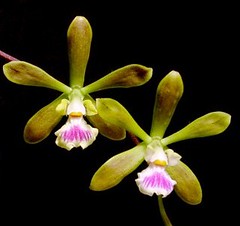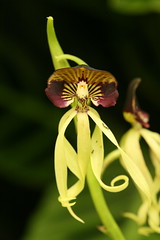Brace yourself for a math lesson, because the name for Encyclia orchid is a geometry lesson. It refers to the shape of the flower’s lip. The lateral lobes of the lip form a circle around plant’s column, so these orchids are classified under the genus name Encyclia, which comes from enkykleomai (Greek for “to encircle”). This genus consists of over 240 species, and boasts a wide range of shapes and sizes of flowers. Some species produce large, showy blossoms, while others produce smaller, not-so-showy blossoms, but the majority of Encyclias produce a fragrance.
Encyclia orchids started out life (along with Cattleya and Laelia) classified as Epidendrums, which was simply a classification name for all epiphyte orchids. The Encyclia genus was first described in 1828 (Encyclia viridiflora) by Sir William Jackson Hooker, an English botanist. Many species of this genus have growing characteristics and foliage similar to Cattleya , and are often used with that genus to create some hybrids.
Though Encyclia orchids now have their own separate genus, they still share some characteristics with their old buddies the Epidendrums. Both produce terminal leaves from thickened pseudobulbs and both produce apical inflorescences. Encyclia does have one distinguishing feature, though. Instead of pointing downward like other orchids, Encyclia’s lip sticks up. As a result, the plants are often called the “Upside down orchids”.
Possibly one of the most beautiful of all these “Upside down orchids” is the “Butterfly Orchid” (Encyclia tampensis). It is Florida’s most common wild orchid (it also grows in Cuba and in the Bahamas) and is protected by law against collection in the wild. Blooms are large (1.5 inches in diameter), yellow-green with a whitish lip and a rose-purple strip on petals and lips. This orchid is known for its beauty and its value for creating hybrids.
Encyclia orchids are native to tropical America and the West Indies, but also grow in Mexico and South America. In their native habitat, these plants grow on trees and shrubs, and prefer climates with obvious wet and dry seasons. Some of the species are lithophytes, but the most are epiphytes and grow well on driftwood, cork mounts, tree fern plaques and potted in rapidly-draining media like fir bark. Because of the diversity of the species, preferred temperatures can vary from 50 to 85 degrees Fahrenheit. These plants love bright light (diffused) and will flourish in a screened setting like a covered patio. In frost-free areas, some species can even be grown outdoors.
The flowers of Encyclia orchids sprout from the top of the pseudobulb. The spike grows upright and produces blossoms in small racemes. Blossoms vary widely in color, but usually are usually green, yellow, brown, orange, or pink. The flowers bloom in succession along the spike, providing blossoms for several weeks.
Encyclia orchids like their roots to stay moist, especially during growth, but they also like to dry out a little between watering. In warmer months, you may need to water as often as three times a week. In cooler weather, every two weeks may be sufficient. For the best results, maintain 50% humidity. After growth is finished, some species will need a break, so watering should be curtailed. These plants like food during growth, so feed every third watering with a one-quarter strength orchid fertilizer.


